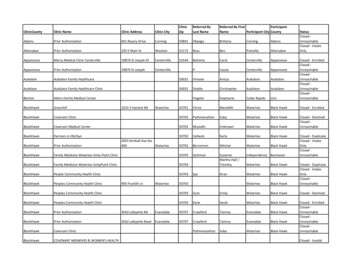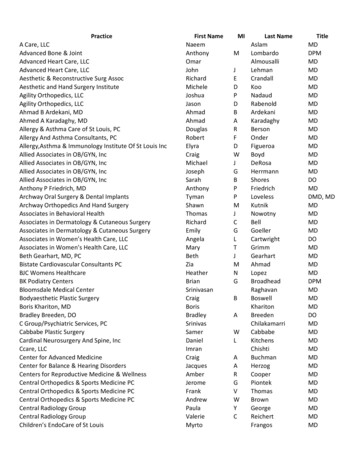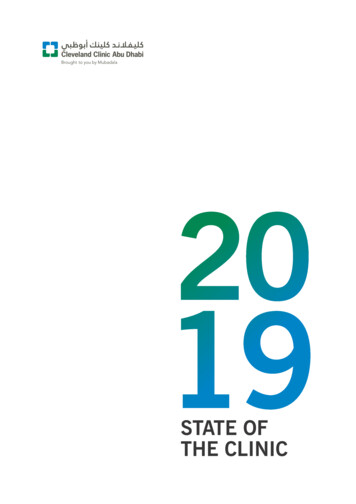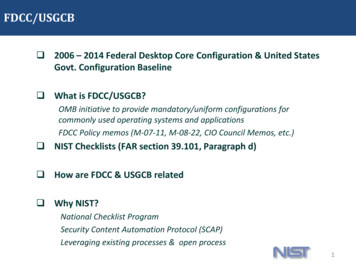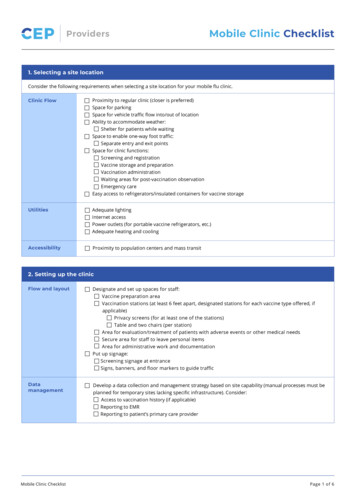
Transcription
ProvidersMobile Clinic Checklist1. Selecting a site locationConsider the following requirements when selecting a site location for your mobile flu clinic.Clinic FlowProximity to regular clinic (closer is preferred)Space for parkingSpace for vehicle traffic flow into/out of locationAbility to accommodate weather:Shelter for patients while waitingSpace to enable one-way foot traffic:Separate entry and exit pointsSpace for clinic functions:Screening and registrationVaccine storage and preparationVaccination administrationWaiting areas for post-vaccination observationEmergency careEasy access to refrigerators/insulated containers for vaccine storageUtilitiesAdequate lightingInternet accessPower outlets (for portable vaccine refrigerators, etc.)Adequate heating and coolingAccessibilityProximity to population centers and mass transit2. Setting up the clinicFlow and layoutDesignate and set up spaces for staff:Vaccine preparation areaVaccination stations (at least 6 feet apart, designated stations for each vaccine type offered, ifapplicable)Privacy screens (for at least one of the stations)Table and two chairs (per station)Area for evaluation/treatment of patients with adverse events or other medical needsSecure area for staff to leave personal itemsArea for administrative work and documentationPut up signage:Screening signage at entranceSigns, banners, and floor markers to guide trafficDatamanagementMobile Clinic ChecklistDevelop a data collection and management strategy based on site capability (manual processes must beplanned for temporary sites lacking specific infrastructure). Consider:Access to vaccination history (if applicable)Reporting to EMRReporting to patient’s primary care providerPage 1 of 6
ProvidersMobile Clinic Checklist2. Setting up the clinic (continued)SuppliesAlcohol-based hand sanitizer (at least70% alcohol)Hand soapCleaning suppliesPPE for staff (masks, eye protection, gloves)Masks for patients who come withoutThermometers (if performing temperaturechecks at screening station)TissuesAdhesive bandages or tape/cotton balls forinjection siteScreening and documentation formsVaccines and diluents (if needed)Prep padsSterile alcohol wipes (individually packaged)SyringesNeedles (varying lengths appropriate for theexpected patient population)Sharps containers (closable, punctureresistant, and leakproof)Emergency medical kit with epinephrine withsigned medical ordersFirst aid kitDisposable table covers that can be changed ifsoiledTechnology (if using):Computers / tabletsPrinters2D barcode readersInternet access or hotspotsOutlet strips (multi-plug) and extension cordsOffice supplies (including pens, printer paper, etc.)WastebasketsTemporary sheltersPrivacy screens (for at least one)One table and two chairs per vaccination station3. Operating the clinicScheduling andbookingappointmentsStagger appointment times to allow for the immunization encounter and post-vaccination observationScreen patients over the phone to ensure they are suitable candidates for the mobile clinic. Those NOT suitableinclude: Patients with previous history of anaphylaxis or allergy to influenza vaccination and, Patients with an unknown history of anaphylaxis (receiving the influenza vaccine for the first time)Provide patients with pre-visit instructions:Do not arrive in advance of appointmentReview criteria for shortened post-vaccination observation period (provide criteria)Wear loose-fitting clothes to allow easy access and expose entire upper arm (or leg for infants)StaffingSchedule extra clinic staff and volunteers for:Monitoring traffic flow and waiting areasScreeningRegistration and consent processesCleaningCleaningClean surfaces and equipment (including the rolling carts) between patients, and at the beginning andend of every shift. Follow COVID-19 environmental cleaning protocols for clinic settings (BCCDC, 2020)ScreeningImplement passive screening procedures at entry with signageImplement active screening procedures at entry. See Ontario COVID-19 Screening Document for screeningchecklist. (MOH, June 11, 2020)Divert screen-positive patients to seek testing at an assessment centre or emergency room as appropriate:Ask the patient to perform hand hygieneProvide the patient with a medical maskMake efforts to ensure the patient has a method of travel that maintains physical distancingMobile Clinic ChecklistPage 2 of 6
ProvidersMobile Clinic Checklist3. Operating the clinic (continued)VaccineAdministrationDo not prepare large quantities of vaccine in advance (there may be low attendance)Use extra caution when handling sharps4. Maintaining the cold chainAdapted from Vaccine Storage and Handling Guidelines (Government of Ontario, 2018)The “cold chain” includes all materials, equipment and procedures used to maintain vaccines in the required temperature range of 2 C to 8 C from the time of manufacture until the vaccines are administered to individuals. Most vaccines are considered to bedamaged at 0 C. The loss of vaccine effectiveness due to exposures to adverse conditions is cumulative, permanent and irreversible.SetupStaffDesignate one person as the lead to monitor vaccine storage and handling practices.Designate one person as back-up to monitor vaccine storage and handling practices.Ensure designated staff understand rationale for correct vaccine storage and handling.EquipmentTemperature Log Book to track:DayTime of each temperature checkCurrent temperatureMaximum temperatureMinimum temperatureName of staff member performing temperature checkRefrigerator:Purpose-built refrigerators are recommended for storing large inventories of vaccines. They ensuremaintenance of 2 C to 8 C internal temperature; ongoing air circulation ensures; evaporator toprevent vaccine from freezing; temperature recovery system.Domestic or bar refrigerators are not recommended for vaccine storage. It is complicated to managetheir temperatures, which makes them unsuitable for vaccine storage unless excellent vaccine storageand handling practices are followed.If using a domestic/bar fridge: contact your public health unit for assistance on requiredmodifications prior to vaccine storage in order to ensure that vaccines will be safely stored.Temperature monitoring device for each vaccine refrigerator and insulated container.Insulated containers for temporary storage in case of power outage.RefrigeratorsetupStabilize the temperature of the vaccine refrigerator before stocking vaccine.Place the maximum-minimum thermometer probe on the middle refrigerator shelf inside an emptyvaccine box.Place the refrigerator out of direct sunlight.Mark the plug clearly so the refrigerator is not unplugged or turned off accidentally.Keep icepacks/gel packs in your freezerReceiving andreturningvaccinesWhen you receive your order, check that you received your full order and ensure that the order matches thepacking slip.Place vaccines in the refrigerator immediately.Store vaccines in their original packaging.DO NOT store vaccines in the door of the refrigerator.If you did not receive everything you ordered, or your order does not match the packing slip, notify yourvaccine supply source (i.e., public health units or OGPMSS) immediately.Always return expired or spoiled vaccine to your vaccine supply source for disposal. The ministry may bereimbursed by manufacturers for returned vaccines.Mobile Clinic ChecklistPage 3 of 6
ProvidersMobile Clinic Checklist4. Maintaining the cold chain (continued)Cold chain managementDaily tasksEnsure your refrigerator is in good working order.Aim to maintain vaccine refrigerator temperature at 5 C, as this gives a greater leeway for protectionfrom temperature fluctuation.Keep your refrigerator door openings to a minimum.Check temperatures. Temperature monitoring and recording devices do not guarantee safety ofvaccines and are not to be considered a substitute for the manual recording of minimum, maximumand current temperatures twice daily.If using refrigerators, check and record the maximum, minimum and current temperatures twice dailyin the Temperature Log Book at the beginning and end of each day.If using insulated containers as temporary storage, see “Management of insulated containers” abovefor temperature check schedule.Reset maximum-minimum thermometer after recording the temperature readings.When using a data logger, the minimum, maximum and current temperatures still need to berecorded manually as a timely alert to any breach in the cold chain.Do not store food, beverages or medical/laboratory specimens in the vaccine refrigerator.Fill the lower drawers and the door with water bottles.Do not overstock your refrigerator with vaccines.Rotate stock so vaccines with the shortest expiry date are used first.If vaccines have been exposed to temperatures below 2 C or above 8 C, contact your public healthunit immediately.Power outageAlways have an alternative means of vaccine storage available.In the Temperature Log Book, document the time and the maximum, minimum and current temperatureinside of the non-functioning refrigerator.Do not allow the vaccine to remain in a non-functioning unit for an extended period of time.Record the time and refrigerator temperature when the electricity supply is restored, and again when thethermometer reading is within 2 C to 8 C.Call your public health unit immediately to report any exposures to temperatures below 2 C and/orabove 8 C.Segregate the exposed vaccines in the refrigerator by placing these vaccines in a labelled container (or bag),marked with the date and time and “DO NOT USE.”Never use or discard the vaccine until your public health unit has assessed the situation.Temporary storage: insulated containersProperly packed insulated containers (coolers) can maintain the required temperature for 3-4 hours, subject to environmental andphysical conditions. Use insulated containers for: Transporting vaccine Temporary storage of vaccine (during clinics or when cleaning the refrigerator) Emergency storage (power outage)Managementof insulatedcontainersMobile Clinic ChecklistExperiment to find the correct combination of icepack(s) and/or gel pack(s) to ensure each insulatedcontainer is able to maintain the required temperatures. See below for instructions on how to properlypack an insulated container.Do not place insulated containers with vaccines in the trunk of a car.Visually inspect the temperature every time the insulated container is opened.Record temperature in the insulated container:Before leaving officeAfter 1 hour of travelUpon arrival at clinicPage 4 of 6
ProvidersMobile Clinic ChecklistTemporary storage: insulated containers (continued)Managementof insulatedcontaiwnersEvery hour during the sessionUpon completion of the session at the clinicUpon arrival back to officePacking insulated containers Ice/gel packs must be correctly conditioned before use. See Preparation instructions below. The risk of freezing vaccines increasesif the icepacks/gel packs are not correctly conditioned. Incorrect use of gel packs is riskier than icepacks because gel packs remain colder than 0 C for longer. Freezing episodes happen very easily in all coolers, usually in the first 2 hours after packing.ItemPreparationInsulated hardsided containerPre-chill insulated container until atemperature between 2 C to 8 C is reachedprior to placing vaccines into the container.Use frozen gel packs or place the container in arefrigerator.Vaccine andtemperaturemonitoringdeviceCheck the accuracy of devices once annuallyand change the battery every 6 months.Inner flexible iceblanketGel packsOuter flexible iceblanketAdditionalinsulatingmaterialMobile Clinic ChecklistCondition in refrigerator at 2 C to 8 CCondition gel packs in freezer to appropriatetemperature for season: Winter transport: 2 C to 8 C. Summer transport: -10 C to -20 C.Condition in refrigerator at 2 C to 8 CN/AUse InstructionsCheck container for damage.Ensure container can close fully and maintainits seal.Position maximum-minimum thermometersensor inside vaccine box.Wrap inner flexible ice blanket aroundvaccines.Place gel packs on top of outer flexible iceblanket. Additional icepacks may be requireddepending on cold-life needed for the length oftransport.Wrap outer flexible ice blanket aroundvaccines and inner flexible ice blanket.Bubble wrap, Styrofoam chips, crumpled orshredded newspaper should be placed inside(bottom, top and sides) the insulated container toallow for cool air circulation.Page 5 of 6
ProvidersMobile Clinic ChecklistMobile Clinic Checklist is adapted from: Guidance on seasonal influenza and antiviral drug use in Canada for the 2020-2021 influenza seasonin the context of COVID-19 (NCCID, Sept 2020); Guidance on the use of influenza vaccine in the presence of COVID-19 (NACI, Sept 29, 2020);Guidance for influenza vaccine delivery in the presence of COVID-19 (NACI, August 5, 2020); Considerations for Planning Curbside/DriveThrough Vaccination Clinics (CDC, July 27, 2020)Mobile Clinic Checklist is a product of the Centre for Effective Practice. Permission to use, copy, and distribute thismaterial for all non-commercial and research purposes is granted, provided the above disclaimer, this paragraph andthe following paragraphs, and appropriate citations appear in all copies, modifications, and distributions. Use of theMobile Clinic Checklist for commercial purposes or any modifications of the Resource are subject to charge and use must be negotiatedwith the Centre for Effective Practice (Email: info@cep.health)For statistical and bibliographic purposes, please notify the Centre for Effective Practice (info@cep.health) of any use or reprinting of theResource. Please use the below citation when referencing the Resource:Reprinted with Permission from the Centre for Effective Practice. (Oct 2020). Mobile Clinic Checklist: Ontario. Toronto: Centre for EffectivePractice.Developed by:With input and support from:This resource was developed with input from and support by Ontario College of Family Physicians (OCFP), Association of Family HealthTeams of Ontario (AFHTO), Ontario Medical Association (OMA) and OMA SGFP, Nurse Practitioners’ Association of Ontario (NPAO) andRegistered Nurses’ Association of Ontario (RNAO).It has been reviewed and endorsed by the Provincial Primary Care Advisory Table (PPCAT) established by the Ministry of Health.Mobile Clinic ChecklistPage 6 of 6
Mobile Clinic Checklist Page 6 of 6 Providers Mobile Clinic Checklist Mobile Clinic Checklist is a product of the Centre for Effective Practice. Permission to use, copy, and distribute this material for all non-commercial and research purposes is granted, provided the above disclaimer, this paragraph and



